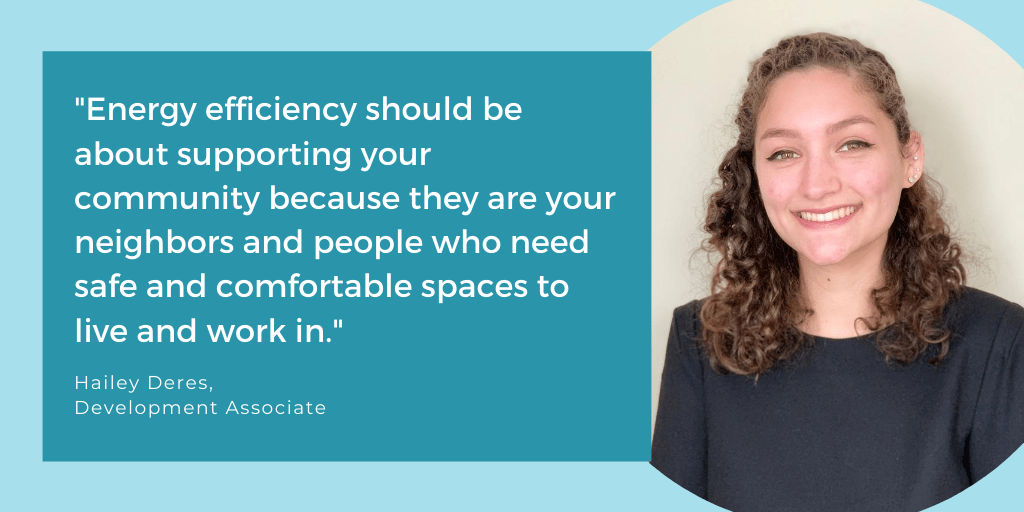IMT helps cities enjoy the economic, environmental, and social benefits of high-performing buildings through building performance policies that create healthy and resilient communities. Collaborating with building owners, tenants, governments, and other city and corporate stakeholders, as well as NGOs and strategic partners, IMT’s expert staff strive to catalyze collective and permanent market change in the built environment. So, who is IMT? Get to know our staff in this blog series.
In this Q&A, Hailey Deres, IMT’s Development Associate, shares her passion for environmental justice and what changes she’s looking forward to seeing within the building efficiency industry in the coming years.

Was there a defining moment when the reality of climate change became personal to you? How does your current work at IMT address some of these climate challenges?
I’ve always been familiar with climate change, but it wasn’t personal for a long time. I lived in Massachusetts until I was 10 and spent every day outside. I knew what global warming was and I even took an environmental studies class in high school which inspired me to consider an environmental career. I learned about ways that you can mitigate your emissions (like walking to school instead of driving to school) or other little things that I knew were environmentally conscious, but I didn’t think about how climate change affected me and my community until I got to college.
There, I was lucky enough to have access to classes that discussed climate change implications beyond the classic “polar bear on the iceberg” photo, and I learned more about the social consequences of environmental degradation. It’s not just melting ice caps – it’s droughts that exacerbate food insecurity, increasingly intense weather patterns that hit coastlines populated by many who can’t leave, sea level rise that threatens to swallow entire cities in Louisiana and Alaska, and so much more.
Regarding my current work at IMT, I talk to foundations, external partners, and hear more directly how different organizations are accomplishing climate goals. I think that even though my work isn’t directly working on programs, it’s still important work that needs to get done.
As the development associate at IMT, what do you find most surprising about the funder landscape as it relates to buildings and climate?
One thing I’ve been very surprised by is how drastically different funders are and how their priorities differ tremendously from organization to organization. Some foundations view climate change more narrowly in terms of specific impacts to prevent, but others take a more comprehensive approach. I’ve been surprised by how much autonomy some funders have given us in decision-making so that we’re able to accomplish goals that align with our priorities and our organizational values.
How has COVID-19 changed the way you think about buildings?
Before I started working at IMT, I didn’t really think about buildings at all. My concentration in school was oceans, atmosphere, and climate. I never took any energy efficiency classes, and I didn’t know anything about how buildings can impact public health and how HVAC systems or the flow of people can affect it. I have been very surprised and excited about how IMT is able to frame buildings as more than static objects that keep us hot or cold as the seasons change.
I also conducted some COVID-19 leadership research for IMT that made me realize that some real estate firms really care about their tenants. I used to think that real estate firms were very hands off and just managed the property. Doing this research on real estate companies revealed that some companies not only care about employee and tenant health, but are willing to go beyond that. For example, during the pandemic some gave vouchers to employees or supported local businesses or have opened up vacant spaces to make room for increased testing capacity. This project showed me all the ways that buildings, and building owners and managers, can serve and give back to communities.
Why is it important for IMT and other organizations in the building efficiency space to address social and environmental impacts of our industry’s work?
Mainstream environmentalism has been a very wealthy and predominantly white movement, so I think it’s important for IMT and its peer organizations to address the social and environmental impacts of our work. There is so much knowledge out there that we don’t have internally. We should be listening and responding to diverse perspectives and experiences so that we develop comprehensive solutions.
Historically, building efficiency work has been about deferring to outside experts, organizations coming into communities and saying, “This is the best solution for your problems.” That has been very shortsighted. By thinking of social issues created or mitigated by our work, we can recognize that climate change is not just an environmental issue, and we can learn from the communities we want to help. By prioritizing their experiences and needs, we are more likely to create meaningful, lasting change and new allies than with the traditional approach of assuming we’re right, and hovering in and out of a community.
For example, my family lives in Texas, which is a huge state, with varied needs. Trying to address climate change at a state level will have definite climate benefits, but to say that the town my family lives in is going to have the exact same solution as a town closer to Houston does not address those gaps. Basically, I just think that organizations need to be thinking about what makes sense for every local community, because there are so many factors that we are accounting for and certain strategies might not account for those factors or gaps.
What does climate justice look like to you as applied to buildings? What are some of the issues that you think organizations in this space can do a better job at tackling?
Climate justice looks like treating climate issues with the urgency that they mandate. By nature of our policy work, we are planning five or six years in the future, so it’s difficult to remember that five or six years from now, a lot of people will be in life or death situations related to the changing climate.
I think buildings should be part of community emergency plans. Resiliency plans need to center efficient use of empty space as a tool to support community needs. We can work with building owners to make sure that people have spaces that they can go to so that they have refuge during global pandemics or heat waves. I want people to care and recognize that we collectively are a large community. Energy efficiency in buildings should be about supporting your community because they are your neighbors and people that need safe and comfortable spaces to live and work in.
What is the most inspiring work happening right now in buildings?
What is most inspiring is that people are very willing to recognize their shortcomings and try to learn. When I was in school, environmental justice work seemed very performative, and recently, I’ve seen more people trying to really listen to the experts and the steps we need to collectively take to move forward.
